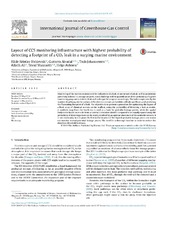| dc.contributor.author | Hvidevold, Hilde Kristine | |
| dc.contributor.author | Alendal, Guttorm | |
| dc.contributor.author | Johannessen, Truls | |
| dc.contributor.author | Ali, Alfatih Omer Mohammed Ahmed | |
| dc.contributor.author | Mannseth, Trond | |
| dc.contributor.author | Avlesen, Helge | |
| dc.date.accessioned | 2016-01-20T09:50:17Z | |
| dc.date.available | 2016-01-20T09:50:17Z | |
| dc.date.issued | 2015-04-04 | |
| dc.Published | International Journal of Greenhouse Gas Control 2015, 37:274-279 | eng |
| dc.identifier.issn | 1878-0148 | en_US |
| dc.identifier.uri | https://hdl.handle.net/1956/10990 | |
| dc.description.abstract | Monitoring of the marine environment for indications of a leak, or precursors of a leak, will be an intrinsic part of any subsea CO2 storage projects. A real challenge will be quantification of the probability of a given monitoring program to detect a leak and to design the program accordingly. The task complicates by the number of pathways to the surface, difficulties to estimate probabilities of leaks and fluxes, and predicting the fluctuating footprint of a leak. The objective is to present a procedure for optimizing the layout of a fixed array of chemical sensors on the seafloor, using the probability of detecting a leak as metric. A synthetic map from the North Sea is used as a basis for probable leakage points, while the spatial footprint is based on results from a General Circulation Model. Compared to an equally spaced array the probability of detecting a leak can be nearly doubled by an optimal placement of the available sensors. It is not necessarily best to place the first in the location of the highest probable leakage point, one sensor can monitor several potential leakage points. The need for a thorough baseline in order to reduce the detection threshold is shown. | en_US |
| dc.language.iso | eng | eng |
| dc.publisher | Elsevier | en_US |
| dc.relation.ispartof | <a href="http://hdl.handle.net/1956/11211" target="_blank">Quantifying uncertainties when monitoring marine environments in connection with geological storage of CO2</a> | en_US |
| dc.rights | Attribution CC BY 4.0 | eng |
| dc.subject | Geological storage | eng |
| dc.subject | Leak detection probability | eng |
| dc.subject | Marine environment | eng |
| dc.subject | CCS | eng |
| dc.subject | Monitoring | eng |
| dc.title | Layout of CCS monitoring infrastructure with highest probability of detecting a footprint of a CO2 leak in a varying marine environment | en_US |
| dc.type | Peer reviewed | |
| dc.type | Journal article | |
| dc.date.updated | 2015-12-21T20:09:38Z | |
| dc.description.version | publishedVersion | en_US |
| dc.rights.holder | Copyright 2015 The Authors | en_US |
| dc.identifier.doi | https://doi.org/10.1016/j.ijggc.2015.03.013 | |
| dc.identifier.cristin | 1251728 | |
| dc.subject.nsi | VDP::Matematikk og naturvitenskap: 400::Matematikk: 410::Anvendt matematikk: 413 | |
| dc.subject.nsi | VDP::Mathematics and natural scienses: 400::Mathematics: 410::Applied mathematics: 413 | |
| dc.subject.nsi | VDP::Matematikk og naturvitenskap: 400::Zoologiske og botaniske fag: 480::Økologi: 488 | |
| dc.subject.nsi | VDP::Mathematics and natural scienses: 400::Zoology and botany: 480::Ecology: 488 | |
| dc.subject.nsi | VDP::Matematikk og Naturvitenskap: 400 | en_US |
